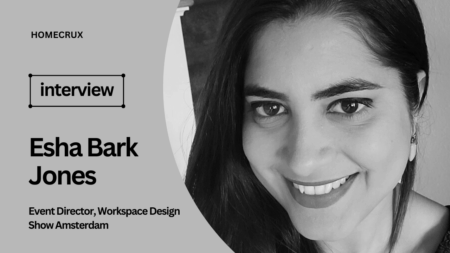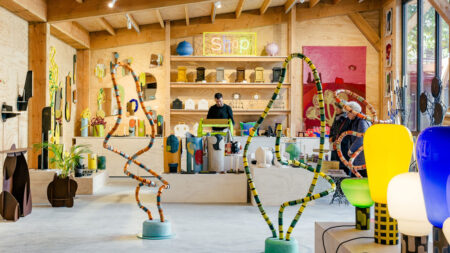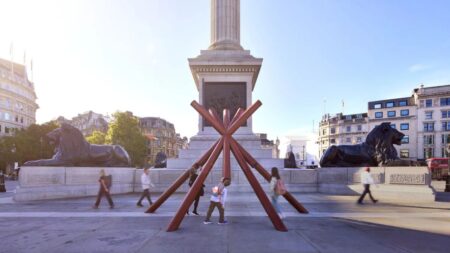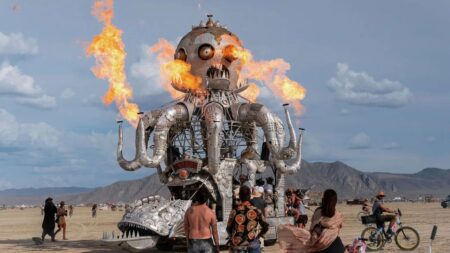Late designer James Irvine, founder of Studio Irvine, and his wife, the current CEO of Studio Irvine, Marialaura Rossiello-Irvine come from two different schools of thoughts. James was a product designer and Marialaura is an architect. James always started a project with a sketch, while Marialaura begins with research and spatial perception. For Marialaura, every project – particularly in product design – must bring an innovation whether conceptual or productive. Meanwhile, James had a more pragmatic approach.
Despite differences in ideas and approach, the designer duo-turned-couple always seemed to arrive at same creative conclusions. Unfortunately, James Irvine passed away in 2013, and left behind were Marialaura and his esteemed architecture and design studio in Milan. It was on Marialaura Irvine to carry on the legacy of her husband – an inheritance that was full of values, quality, and field experience.

Mentored by famous Italian architect Riccardo Dalisi and groomed by James Irvine, Marialaura Rossiello Irvine was up for the challenge and has been the creative force behind Studio Irvine for over a decade. In the past ten years, the designer-turned-entrepreneur has not only collaborated with esteemed clients including Arper, Muji, Thonet, M+, Olivari, Jaipur Rugs, and many others but also sculpted her expertise to create thoughtful designs like PAF PAF lounge chair.
Homecrux got in touch with the CEO of Studio Irvine to know more about her journey as she continues to redefine the landscape of contemporary design, seamlessly blending her rich Italian heritage with a global perspective.
Homecrux (HC): Please tell us a little about yourself. How and when did you meet James Irvine?
Marialaura Irvine (MI): I met James when I was working as a consultant for Danese Milano. At that time, I was involved in the strategic positioning of the historic design brand with the new ownership. Naturally, we collaborated with both established and new international designers. I worked alongside designers like Enzo Mari, Marco Ferreri, Paolo Rizzatto, Naoto Fukasawa, and many others. That’s where I met James.
HC: What’s the story behind the inception of Studio Irvine? What are some of the notable projects that you and James have worked on together?
MI: Studio Irvine was founded by James in the early ’90s. He worked simultaneously as a partner of Ettore Sottsass and for his own studio, focusing on product design with companies like Mercedes Benz, Zumtobel, and Cappellini. I joined the studio discreetly with my clients towards the end of 2010. We shared everything: projects, ideas, and, of course, the building of a family. Our best project.
HC: After James, what motivated you to keep the design studio going? Would you be comfortable talking about your husband’s legacy?
MI: It was a natural intuition. A bold and somewhat reckless choice but filled with professionalism and respect. My goal was to continue and evolve, not to be stuck in the past or in memories. I chose to carry on his legacy because it was full of values, quality, and field experience. A universal method of research, precision, and curiosity. I enriched this method with my own professionalism.

HC: What does Marialaura do in her leisure time when not conjuring the next winning design?
MI: I play the piano, embroider designs by hand, read, and visit all the art exhibitions I can. Art is my comfort and continuous source of inspiration. I travel a lot with my children.
HC: As a female designer and entrepreneur, what challenges have you faced in the industry, and how did you overcome them?
MI: When designing, I always think about the product’s end life. I don’t design just to create another piece. The approach has radically changed since the ’90s. You cannot design without a future consciousness. The ambition is to design timelessly. Create concepts and products that are not fleeting and do not chase trends.

HC: Your designs are known for their minimalist and functional approach. What inspires your design aesthetic and how do you ensure that form follows function in your work?
MI: For me, form is a consequence of both the design and production process. My goal is not to chase a precise aesthetic; that would be an error and would lead to style. Style goes out of fashion; research and method do not. They are universal and evolve.
HC: Collaboration is important in the design sphere. How does Studio Irvine approach collaboration with clients, manufacturers, and other designers to achieve successful outcomes?
MI: The process is always the result of teamwork, both within my studio’s team and with the client, whether private or a company. It’s a continuous exchange of ideas, development, and growth. Depending on the project, I often create teams by involving external professionals, so I enter and exit my ‘design nest’ and put myself to the test.

HC: You have clients like Arper, Mattiazzi, Matteo Brioni, MDF Italia, and Thonet. How do you handle pressure and ensure timely delivery?
MI: When designing a product, timelines are always extended, unlike architecture where you have to produce and control daily. Our method involves continually archiving information, sketches, drawings, and emails. If I forget something, I review the book and pick up the thread. Organization is key, of course. It’s all natural, like creating a biological clock for projects. I must admit my mind never really switches off.
HC: Sustainability has become increasingly important in the design industry. How does Studio Irvine incorporate sustainable practices into the design process and the products you create?
MI: By being conscious of the material used and understanding the project’s lifecycle. My project selection starts not with the companies but with the materials: clay, stoneware, cement, wood, etc., and from there, I choose the best interpreter as a company. Then, the challenge is how to maximize their industrial capabilities to develop often groundbreaking projects.
HC: Your designs often embrace simplicity and timeless elegance. Can you discuss the design principles that guide your creative process? What’s your design philosophy?
MI: My mission is to simplify, to improve the overall design and its production. My method can be summarized in a list of key principles that guide us, depending on whether we approach the project from the point of view of art direction, product design, or architectural design.
HC: Innovation is key in staying relevant in the design world. Can you share some examples of how Studio Irvine has pushed the boundaries of traditional design thinking in your projects? What’s next for you?
MI: My vision focuses on research and process. The final product is the result. I’m interested in communicating everything behind it and how a radical thought connects all projects. There’s a common thread in my projects, and it is the risk, the challenge. Putting oneself in the front line and trying to introduce a new concept. I’ve always had a spirit that whispers to go against the current. Currently, I am drawn to the material glass and consequently to light.
HC: Studio Irvine works across various design disciplines, from rugs to furniture to tile design. How do you adapt your design approach to different types of projects?
MI: Research. Every project involves specific research: color, production process, storytelling of an experience, almost never about the shape. In the end, projects magically converse with each other: the Paf Paf chair for Mattiazzi perfectly complements the Bonnet table for MDF Italia with the Licheni wallpaper designed for Fabscarte, etc.
HC: Can you tell us about a particularly memorable or challenging project that Studio Irvine has undertaken, and how it impacted your approach?
MI: The projects that challenged me are my favorites. Those projects where, upon receiving the brief from the company, I had no idea how to proceed. Like the broom for Muji, a popular product sold worldwide and marketed as an anonymous design. And the Paf Paf chair for Mattiazzi: a modular and free-thinking product in both concept and material. It exudes personality and risk.


HC: What advice would you give to aspiring female designers looking to establish their own studios or leave a mark in the industry?
MI: The key words are tenacity, boldness, intuition, and professional integrity. Don’t let anyone define you or put you in a corner with a label. Move, always move with ideas and research. Amaze.
We thanks Marialaura Irvine for making time out of her busy schedule to answer this interview!
Follow Homecrux on Google News!




